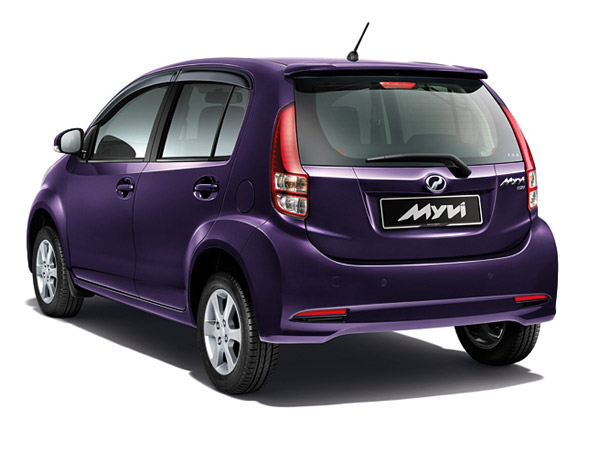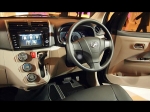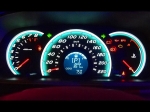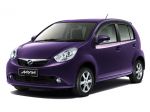18 June 2011 - The all-new Perodua Myvi has been launched in Malaysia, replacing the first-generation Perodua Myvi which has held top spot on the sales chart for five consecutive years since its launch in May 2005. With 487,400 units sold since then, the five-door hatchback has certainly been popular with the public – that it has been the country’s best-selling model for five years, from 2006 to 2010, states it all.
Three trim levels (Standard, Premium and Elegance), two transmissions (four-speed automatic and five-speed manual) and one 1.3-litre engine give Malaysians six Myvi variants to choose from. In metallic colour and inclusive of insurance, the 1.3 Standard SX (M) costs RM 44,400, the 1.3 Standard EZ costs RM 47,400, the 1.3 Premium SXi (M) costs RM 47,400, the 1.3 Premium EZi costs RM 50,400, the 1.3 Elegance SXE (M) costs RM 54,400, and the 1.3 Elegance EZE costs RM 57,400.
Five metallic colours—Ebony Black, Glittering Silver, Medallion Grey, Pearl White and a new Mystical Purple—are available for selection. Choosing the Ivory White solid colour will save you RM 500 from the abovementioned prices, while going for the special metallic colours will cost you RM 400 more.
The profile of the 2011 Perodua Myvi appears largely unchanged from before, despite being 60 mm shorter in length and 5 mm lower in height. The wheelbase, width and front/rear tracks remain untouched. Perodua spent considerable effort on the upper body styling, which now includes more pronounced character lines and wheel arches, a steeper sloping bonnet, halogen projector headlamps, LED side-mirror indicator lights, and LED tail lights.
Perodua claims that aerodynamics played a part in the design of the all-new Myvi. In particular, the front bumper features an “air spat” and the rear bumper gets an air vent on either side. 175/65 R14 tyres are the same as before. The Standard trim only includes steel wheels, with six-spoke alloy wheels, along with electric retractable side mirrors and fog lamps, reserved for the more expensive trims. The Elegance trim tacks on a body kit and chrome door handles.
The interior width and height have decreased by 20 mm and 5 mm, respectively, compared with the previous Myvi’s, but interior length has increased by 15 mm, meaning more legroom for front and rear occupants. The boot capacity of 208 litres and 595 litres (60:40 split-fold rear seats folded flat) is less than the previous Myvi’s at 225 litres and 630 litres.
The cabin is dominated by a dashboard design that differs from the Toyota Passo’s. The unique centre console design features an integrated audio head unit and air-con controls borrowed from the Perodua Alza, and the automatic gear lever is relocated to the centre console from the floor; the manual gear lever is still mounted on the floor.
The new instrument panel deserves mention as well. The Premium trim adds USB and Bluetooth connectivity to the Standard trim’s radio/CD/MP3/WMA capability and four speakers. The Elegance trim is the only to come with a 6" touch-screen LCD and built-in GPS navigation, plus SD card support and a DVD player. Leather upholstery is naturally only standard with the Elegance trim.
Beneath the sheet-metal, the 2011 Perodua Myvi soldiers on with the previous Myvi’s platform and the familiar 1.3-litre K3-VE engine that now produces 90 hp at 6000 rpm and 117 Nm at 4400 rpm—up from 86 hp and 116 Nm. Significant to better performance and efficiency is the installation of electric power steering in place of the previous hydraulic-assisted steering. The fuel economy improves by 15 percent to 14.6 km/litre for the automatic variants and by 4 percent to 17.5 km/litre for the manual variants.
Dual front airbags, five three-point seatbelts, driver’s seatbelt pre-tensioner and ISOFIX child seat mounts are standard across the model range, though ABS, EBD and brake assist are only included on the Premium and Elegance trims. The front end structure even adopts built-in pedestrian protection measures.
With support from Daihatsu, Perodua’s technical partner, the all-new Myvi costs RM 220 million to develop, requiring input from 200 local R&D personnel, 27 months of development time and 85 percent localisation of parts and components. Those figures compare favourably against the RM 280 million, 33 months and 80 percent localisation for the development of the outgoing Myvi.





